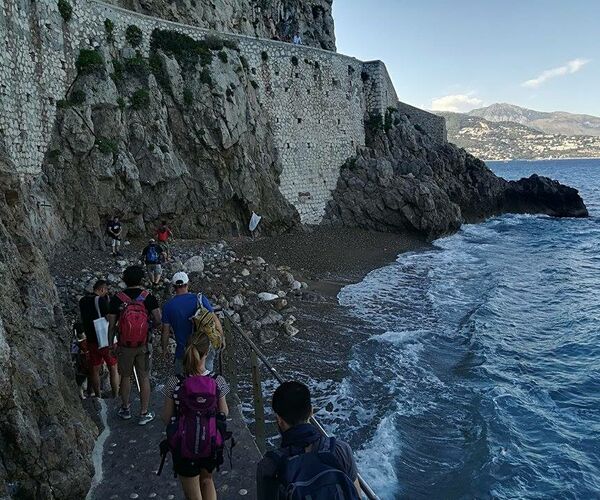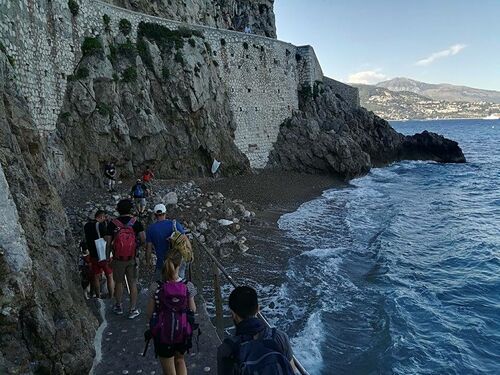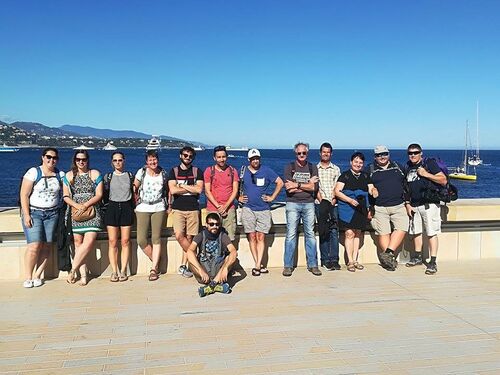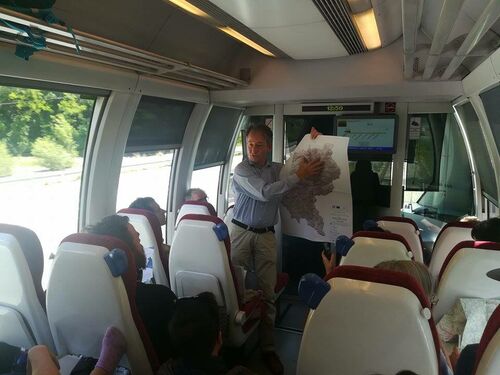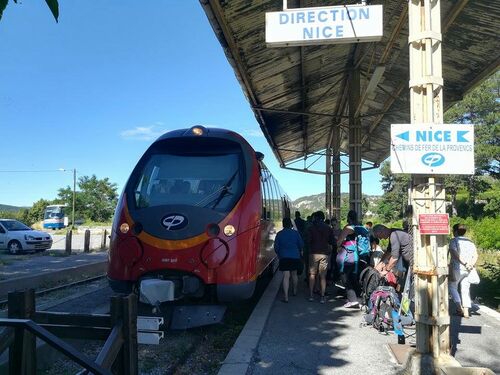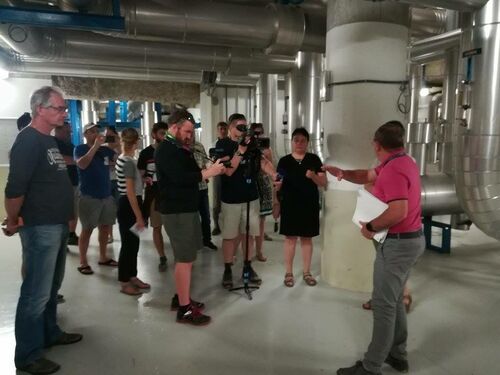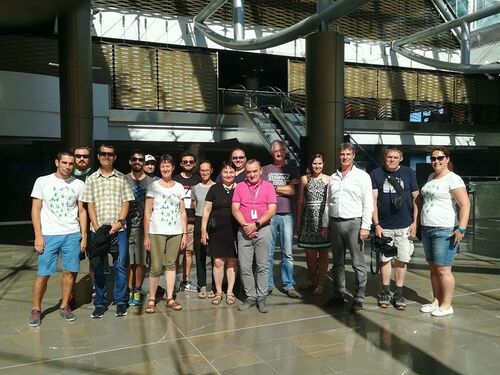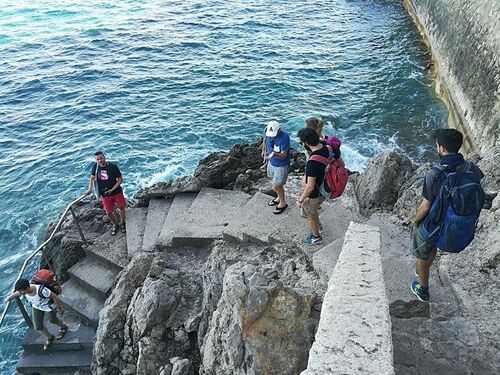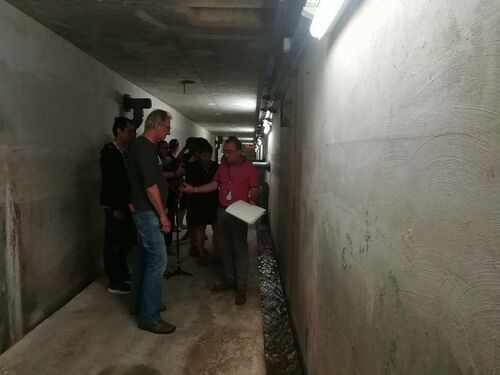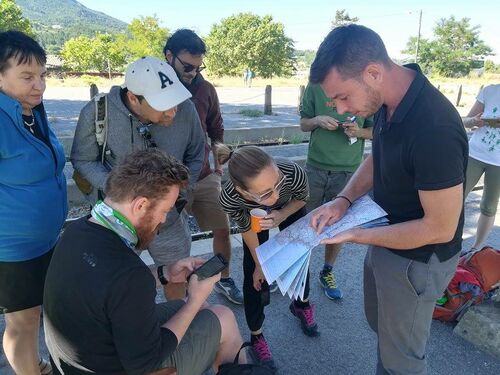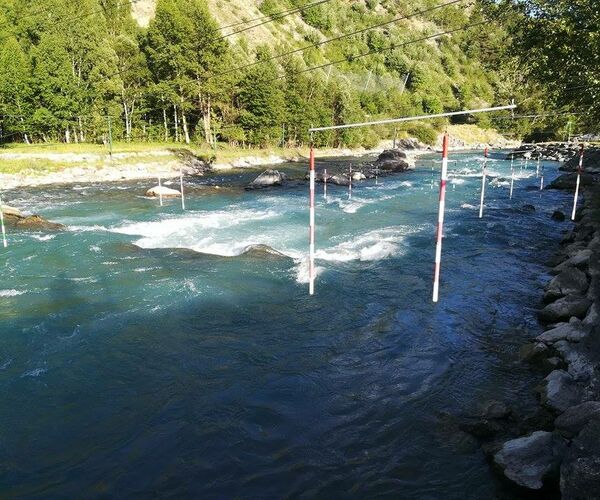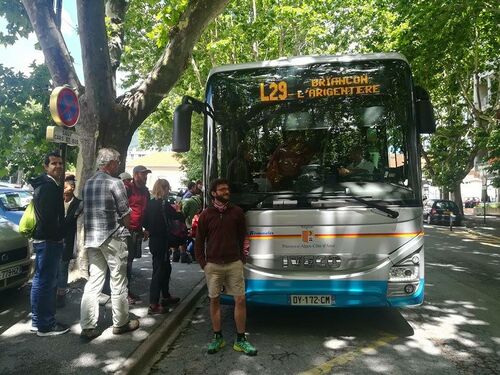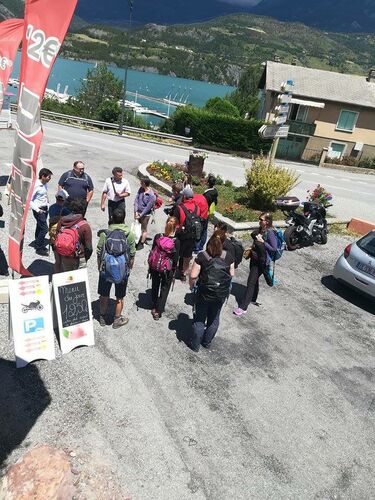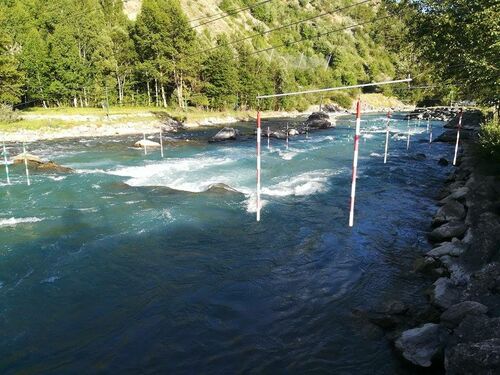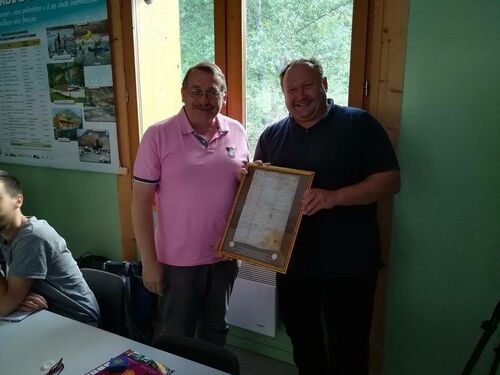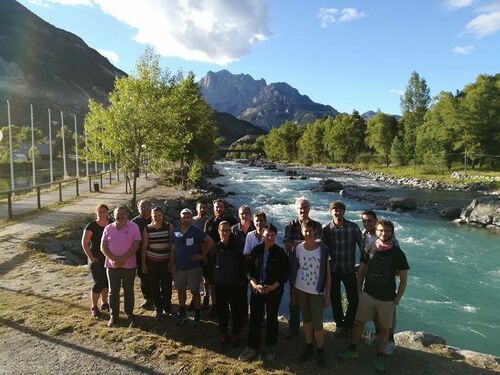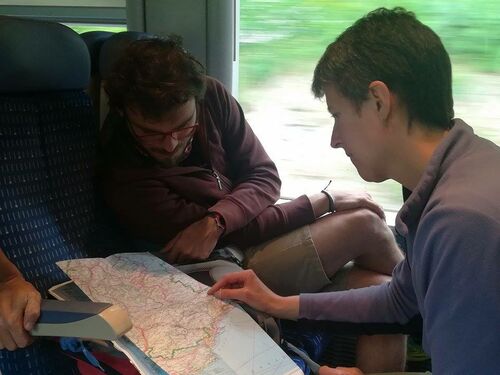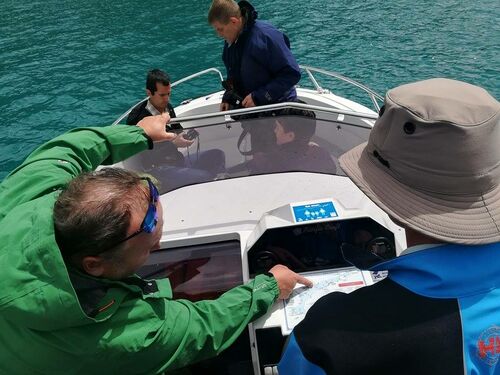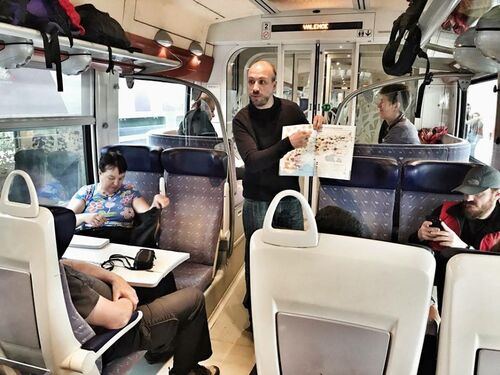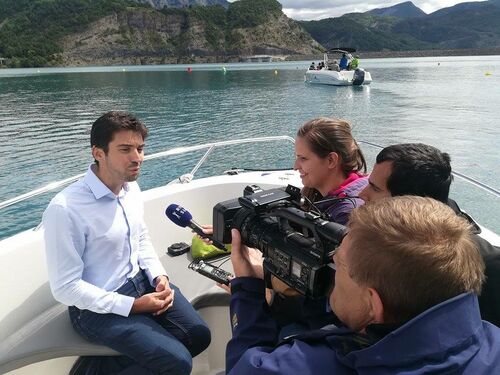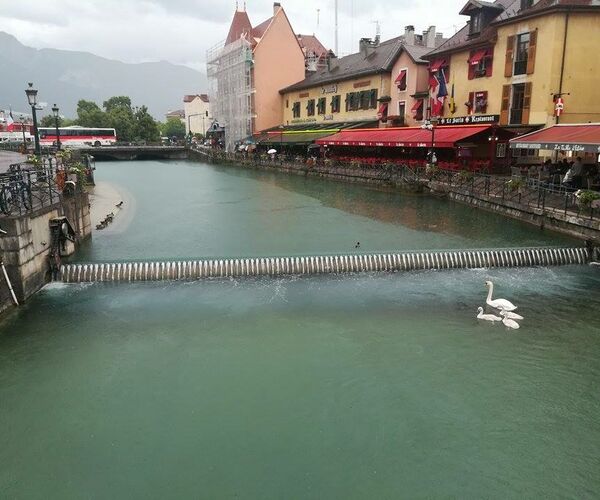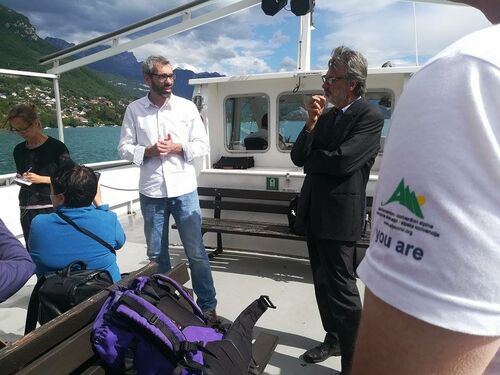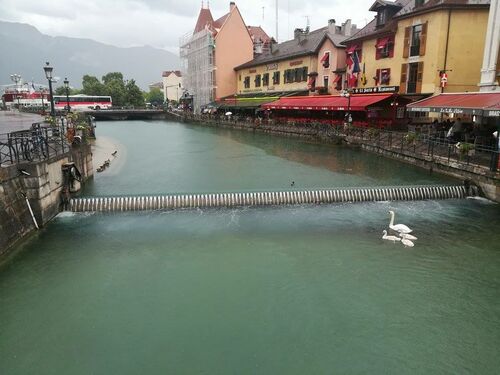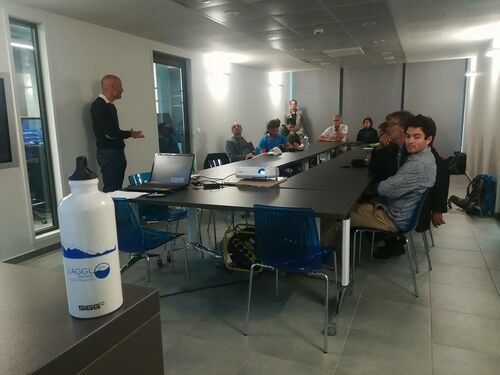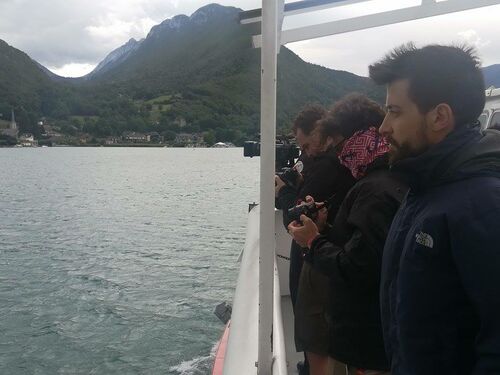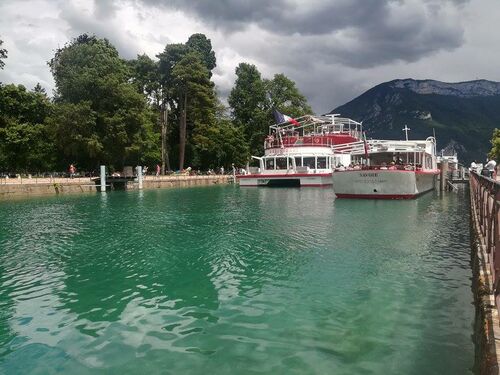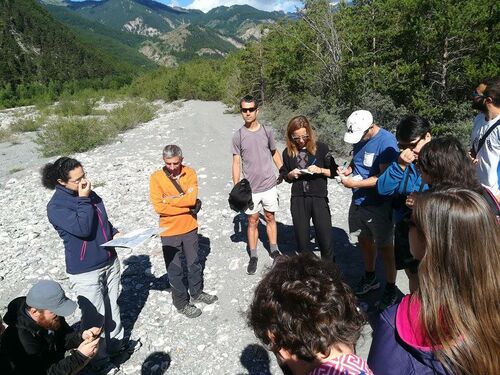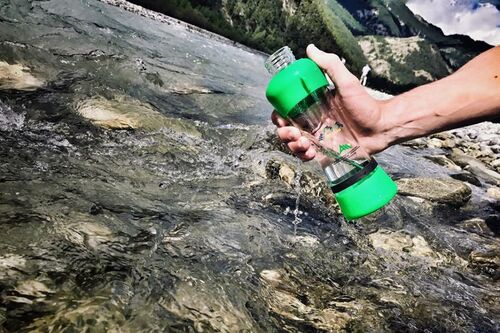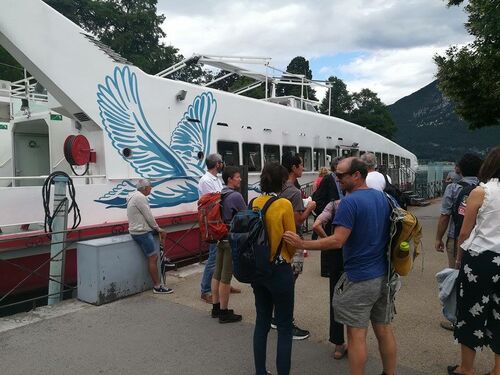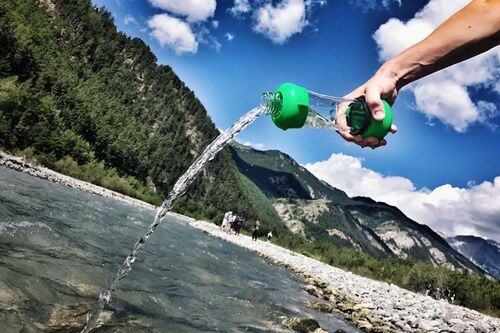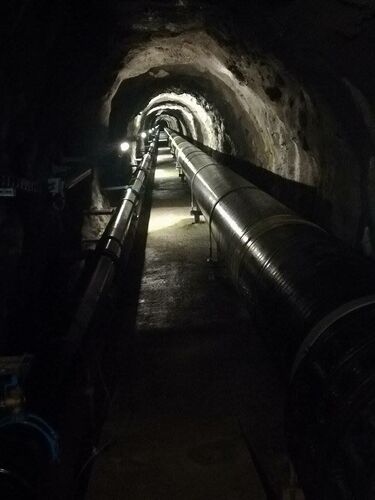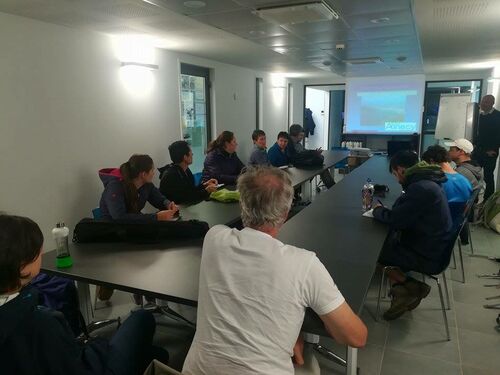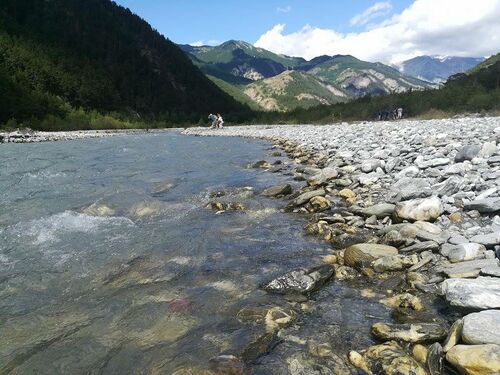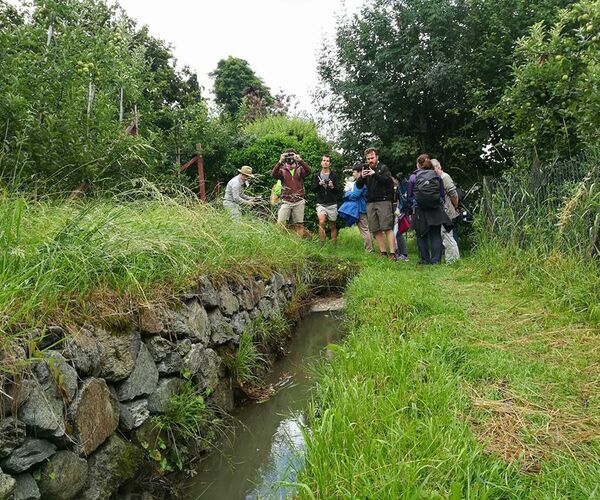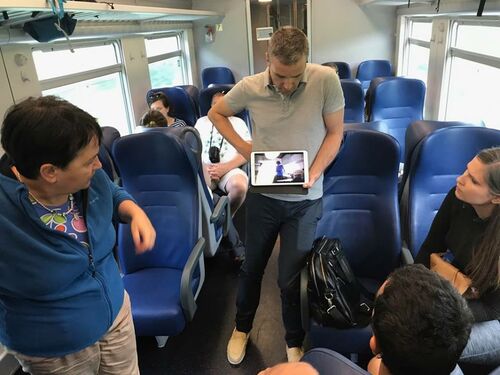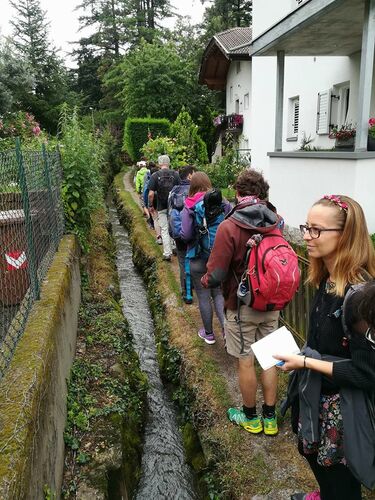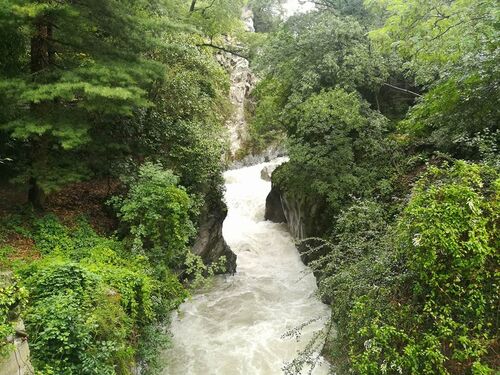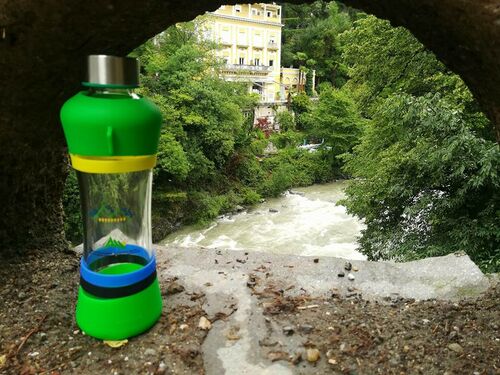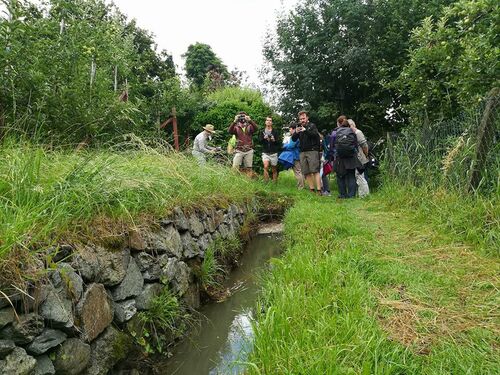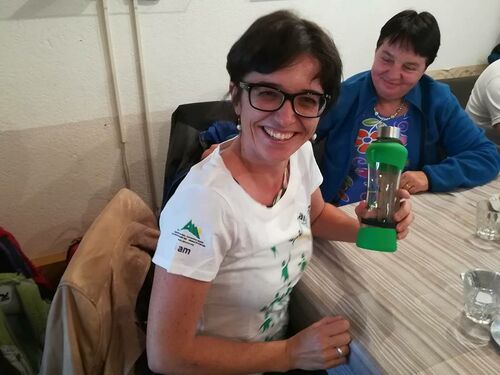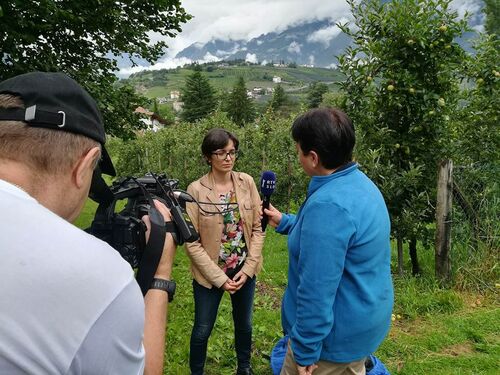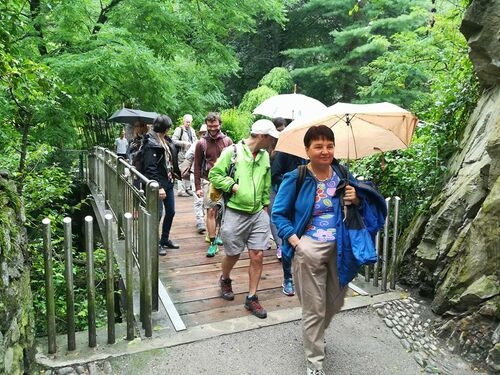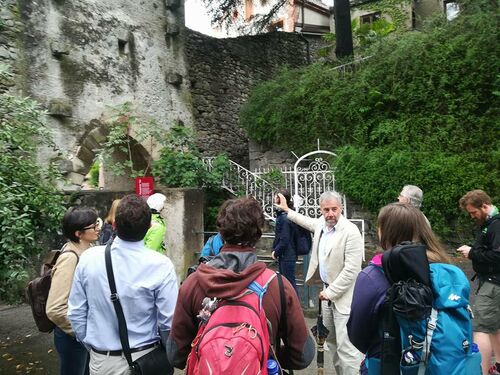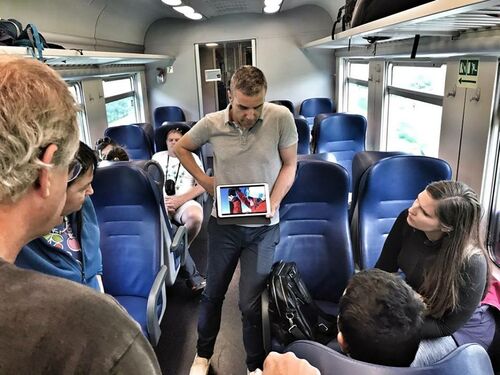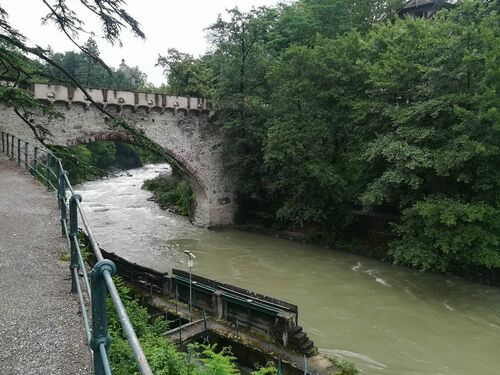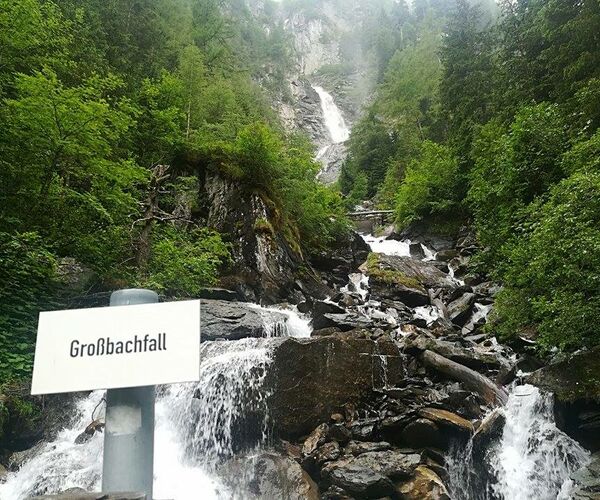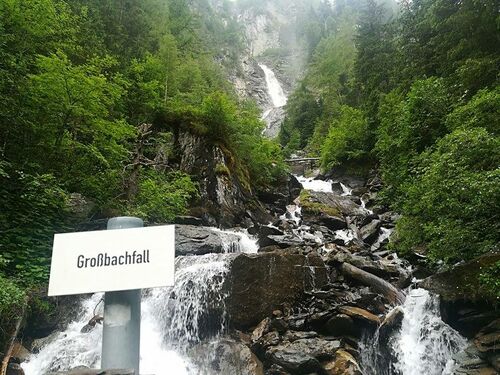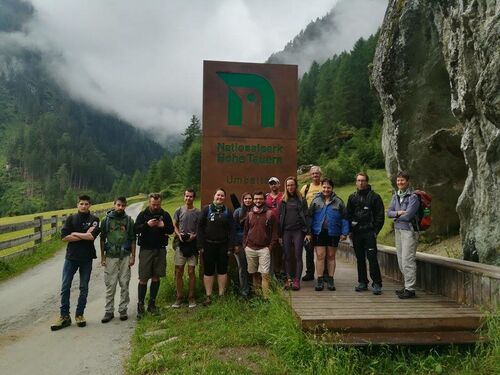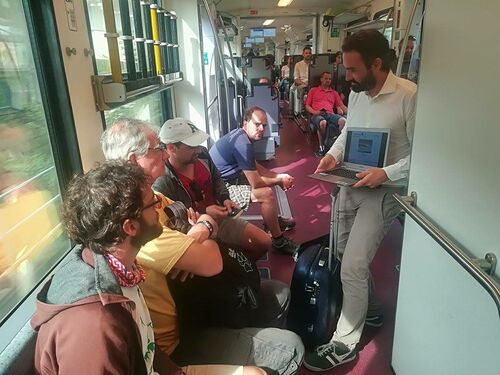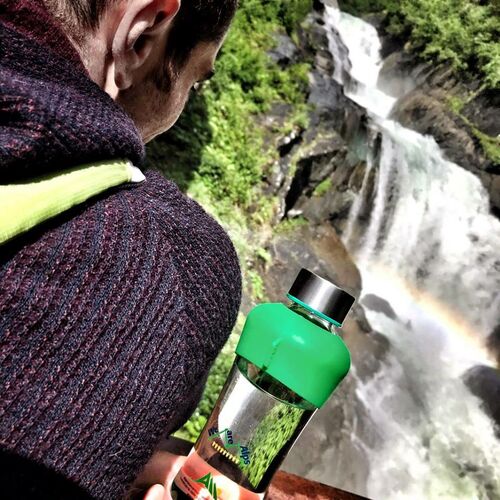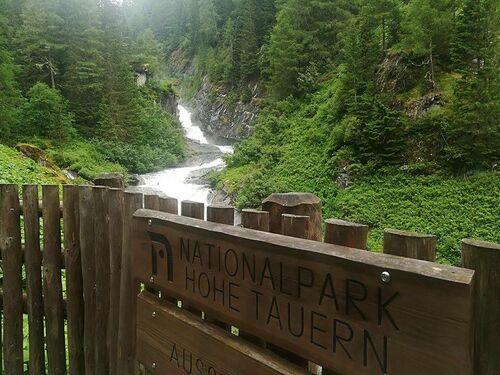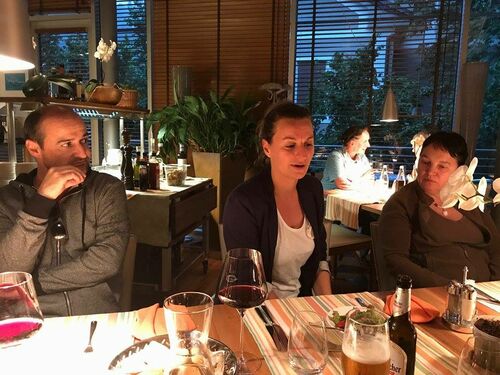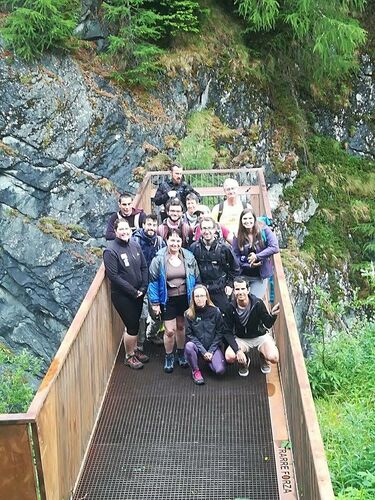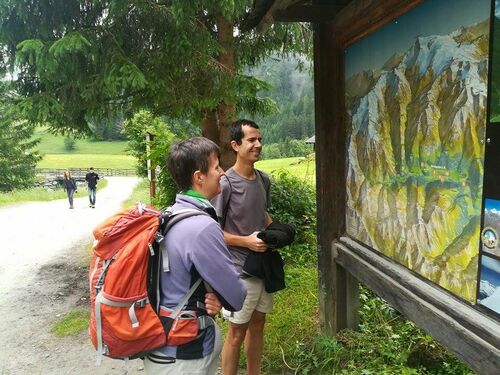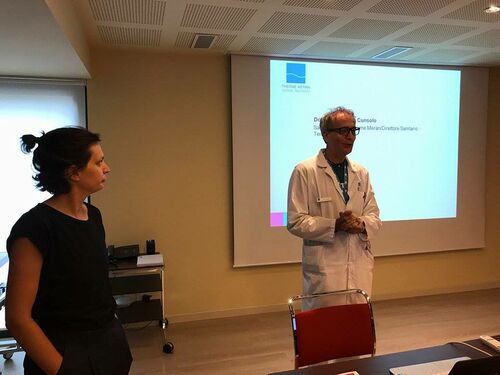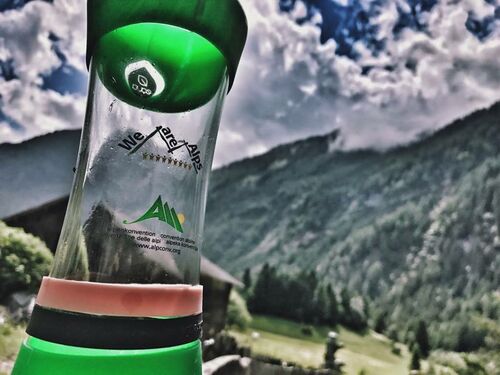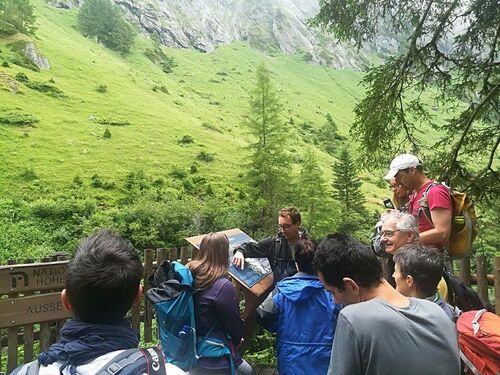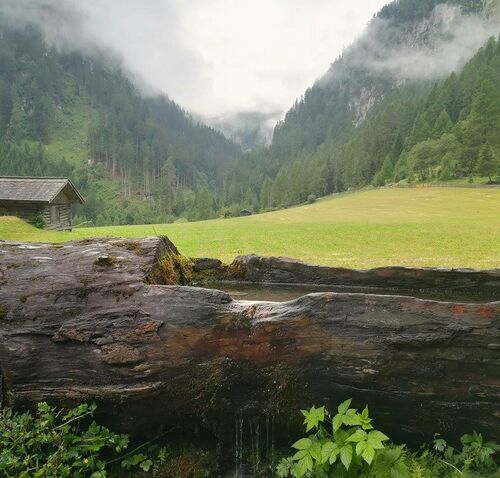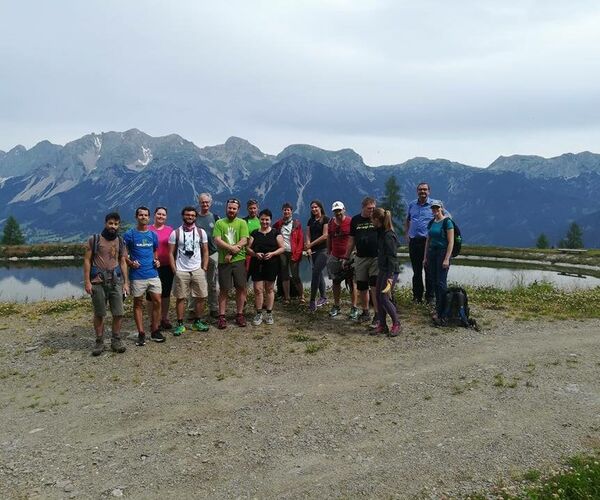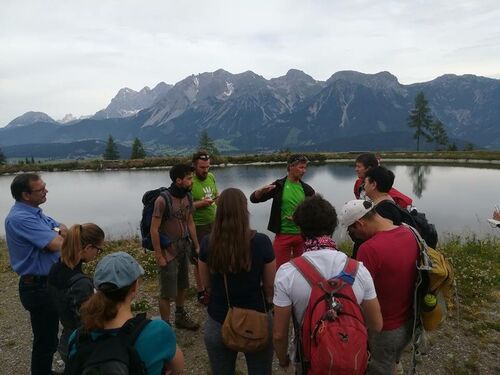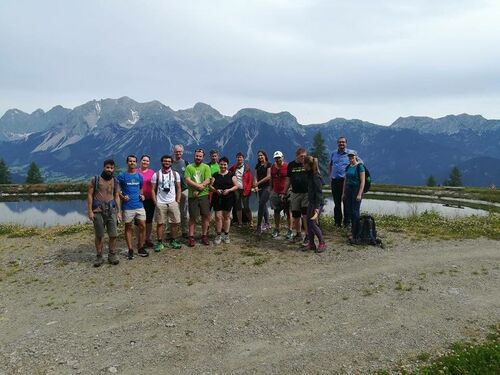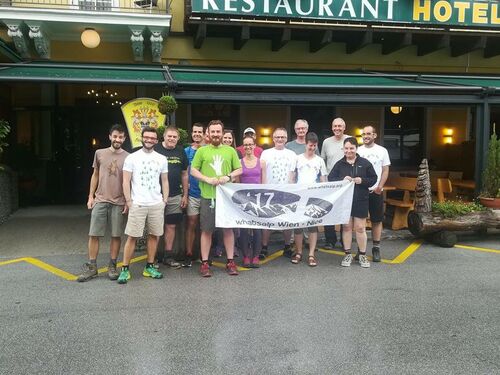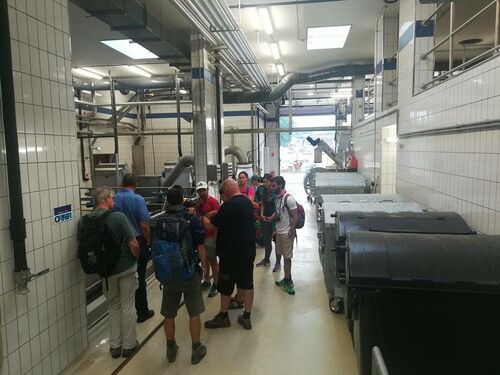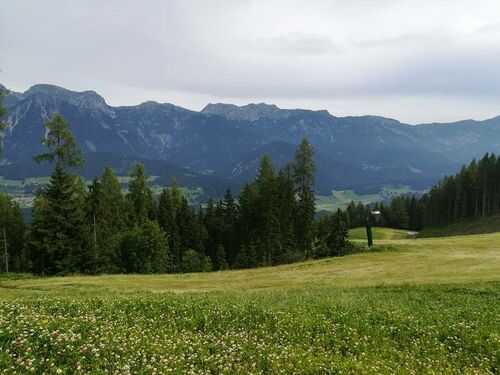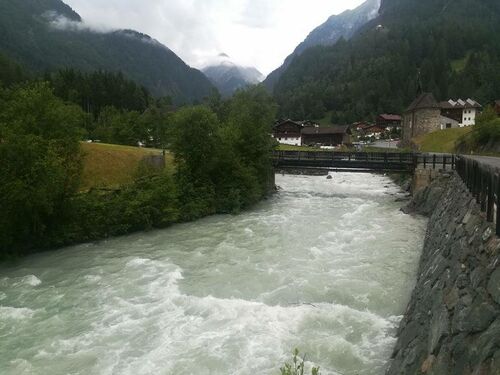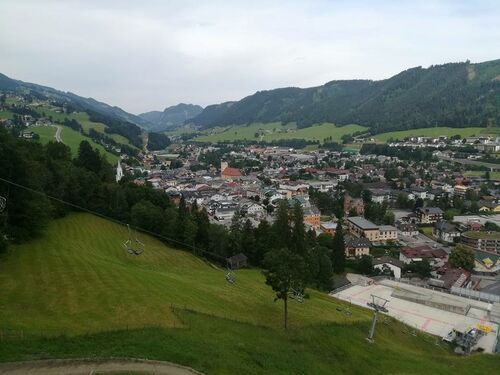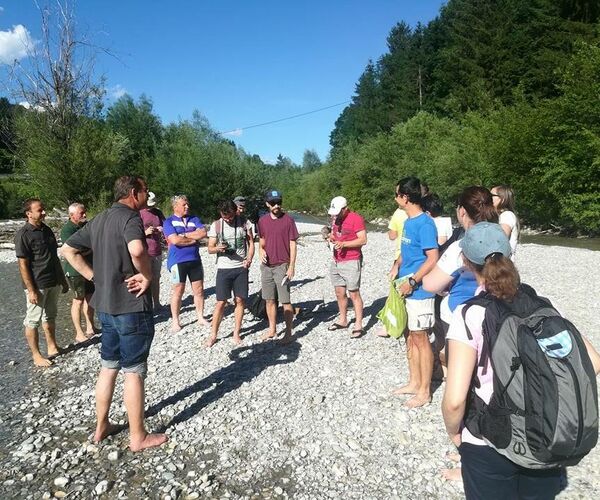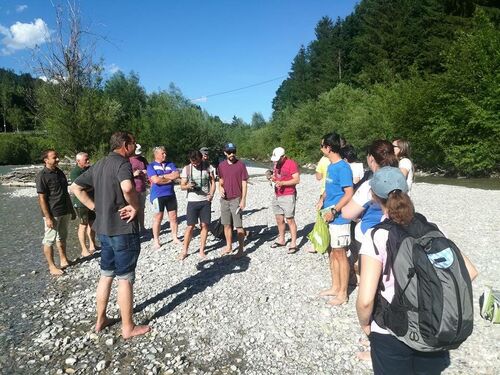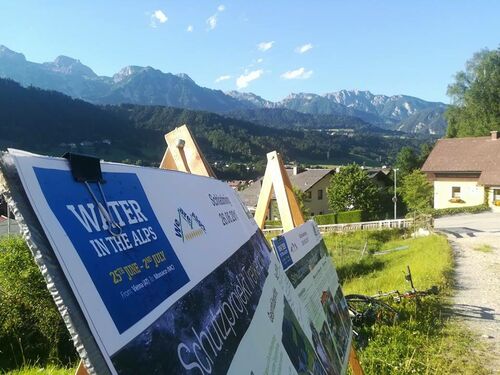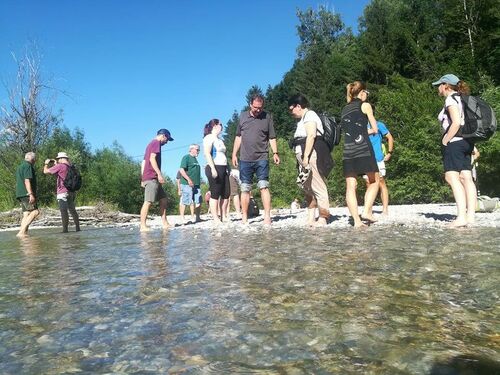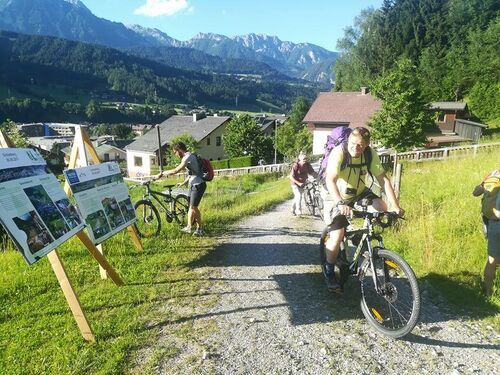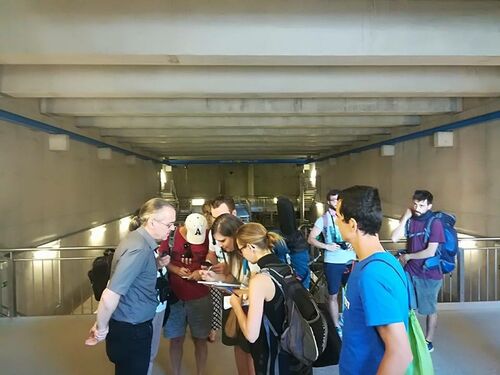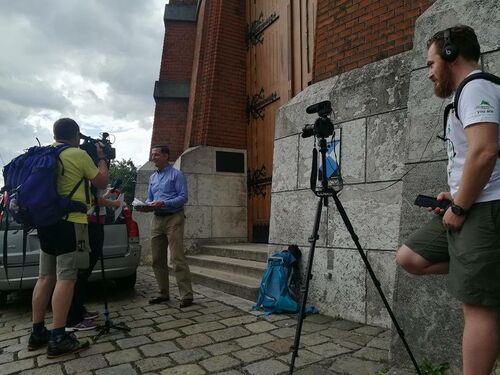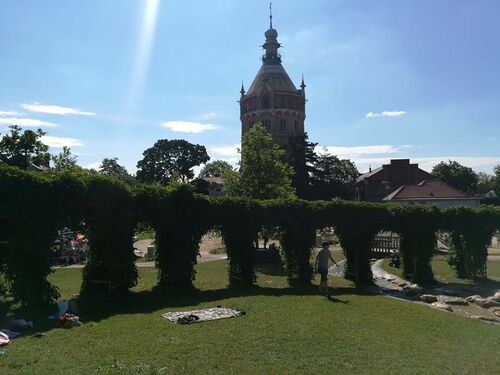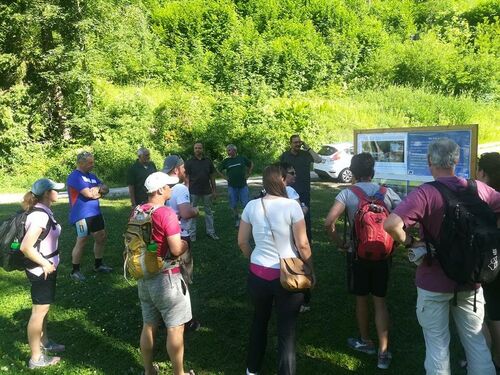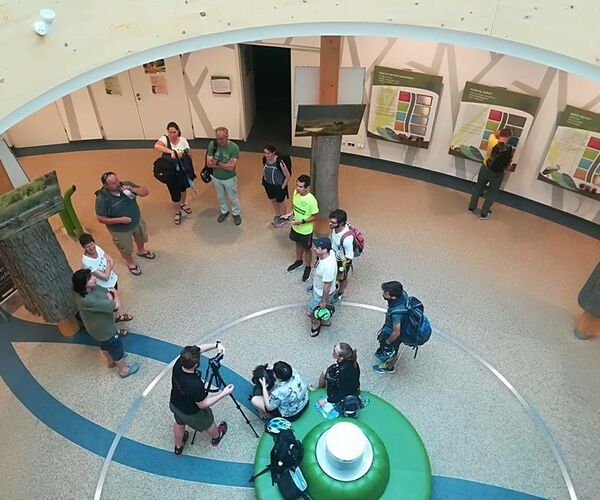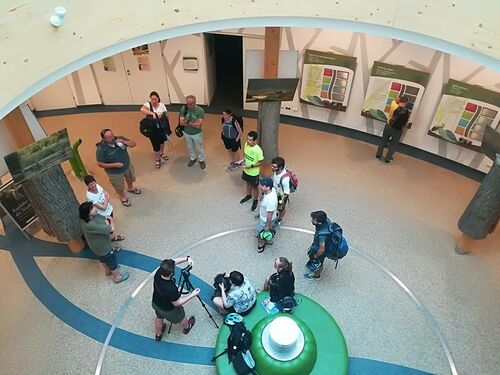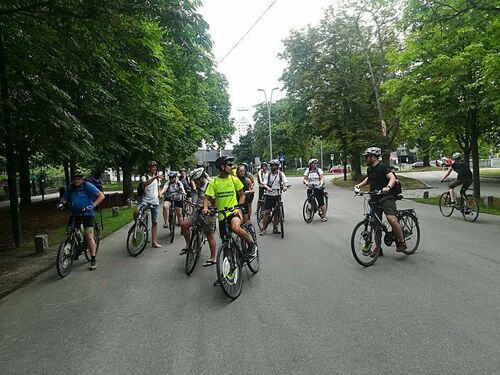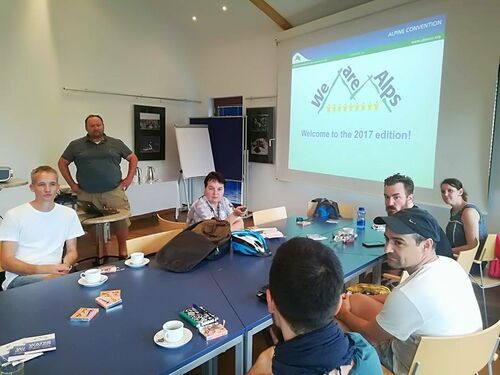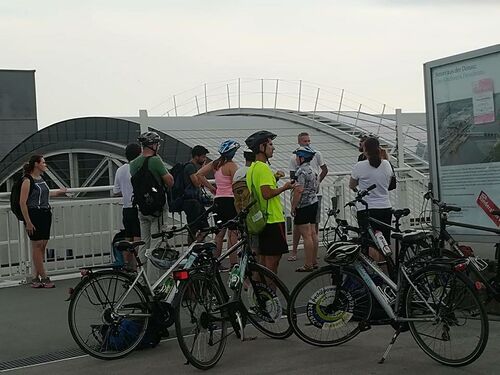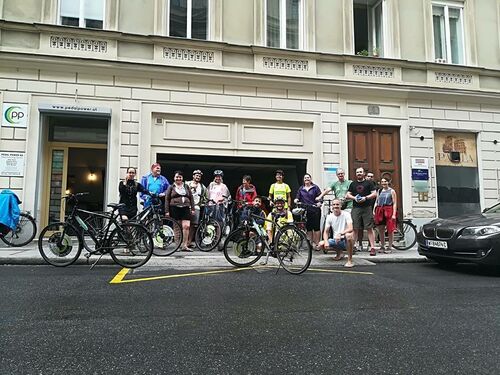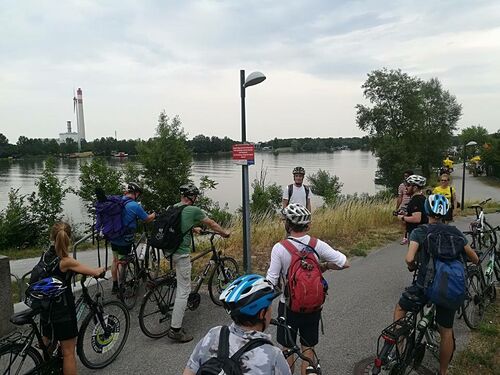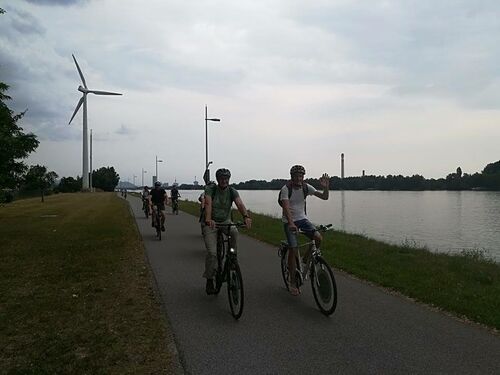We are Alps Tour 2017
We are Alps Tour 2017 only exists in English:
Water in the Alps
This year’s focus was on the topic of Water in the Alps. The small group of journalists was taken for a week-long excursion across the Alps, using sustainable means of transport, that are alternative to private car; trains, buses, boats and bicycles were used, and a part of the tour was done on foot. Throughout the tour people from the Alps –amongst others experts, representatives of the civil society, of different economic sectors and different administrative levels, business people, workers, farmers and politicians – were met, therefore the name of the journey: “We are Alps”.
The tour took place between 25 June and 2 July 2017 on a route linking Vienna (AT) and Monaco, with activities on the topic of Water in the Alps: from drinking water to water sports and spa, from water ecology to irrigation, hydroelectricity and more, also highlighting the issues of natural disasters and climate change. The group experienced various rivers and lakes in Austria, Italy, Switzerland and France with a finish by the sea in Monaco. The participants had the opportunity to meet the actors of flagship projects contributing to innovative water management.
All journalists taking part in the tour commited themselves to publish at least two articles or broadcasts about the crossing - you can read the articles here:
Blog
written by: Raul Cazan
There should be a ‘Day 0’ in any yearly We Are Alps! program and that would be the day that one journalist hops on the train for a long ride to reach his peers that, for more than a week, tackle the beautiful mountain range in a sustainable crossing. My own ‘Day 0’ was on the banks of the Vistula rushing to the Warsaw Central Station to catch the night train (a rarer sight on the railways of Europe) to Vienna.
The train took me straight to the wavering shores of “Europe’s aorta” in the Donau – Auern National Park.
Why would a mountain crossing start in the flooded lowlands of the Austrian capital?
Because in water lies the most overt interconnectedness. The actual birthplace of the Danube is not exactly the Black Forest Mountains, but a glacier as Morteratsch in Switzerland. Therefore the lowest of the lands such as the Danube Delta with its sturgeons striving for the upstream spawning is directly connected to the rapidly melting Alpine glaciers.
Also, a city like Vienna, a metropolis of two million inhabitants is “entirely connected to the water of Alps that is being furnished to all its population. For hundreds of years there is a strong link between the mountains [of the area, n.n.] at 2-3 hours drive away from Vienna to bring in the water for the people. In any place in Vienna, the water on the tap is actual mountain water; this is what people drink. So we wanted to show that two million citizens outside the perimeter of the Alpine Convention is still depending very much on this alpine resource – water,” stressed Markus Reiterer, Secretary General of the Alpine Convention.
And that precious liquid is not only gushing up at all the water fountains in town, but brings about loads of energy from the 11 hydropower stations in all Austria. Almost 60% of the Austrian electricity is hydro-generated and “that is good for reduction of CO2 emissions,” says Christian Schilling water expert at the Austrian Federal Ministry for Agriculture, Forestry, Environment and Water Management. He speaks to us on the dam of the 107 MW capacitated hydropower station of Freudenau, between the city of Vienna and the Danube Isle.
This, however, comes at a price, he follows. “Starting 2009 follow a prioritization approach that leads to the special protection of fish.” Ever since the enforcement of the Water Framework Directive, Verbund – that is the state owned company that operates power plants on the Danube - spent Euro 60 million on fish migration projects.
Amongst the flagship species there are sturgeons whose ability to swim upstream from the Black Sea has been cut off by hydropower projects. “In Austria we have only the sterlet, so we bring it back - there is a farm right here on the Danube isle,” adds Schilling. The Danube Isle was artificially built in the 1970s and was meant for flood protection: it divides the actual Danube and the Small Danube, a canal.
The Donau Auern National Park is actually the first green outcome in the tension between hydropower developments and the need to preserve pristine flood lands. Conservationists in December 1984 stood against such a development and led towards the creation of the protected area. “It was the day that marked the commencement of ecological awareness in Austria,” states Reiterer.
Water is not given a specific protocol in the Alpine Convention. Nevertheless, the „Water management in the Alps” platform was established in 2009 after the adoption of the second Report on the State of the Alps on „Water and Water Management Issues,“ says Spela Petelin from the Water and Investment Directorate of the Environment’s Ministry of Slovenia, the two-year manager of the initiative. The platform is currently focusing on fighting drought periods in the Alpine Region and drawing guidelines on small hydropower.
Coming up in the morrow: flood protection on River Enns and the Trenkbach torren t in Schladming. Stay dry!
written by: Raul Cazan
Though it might sound as an impiety, we walked over water. A reservoir of Alpine water that supplies the Austrian capital’s city centre lies right underneath the Vienna Water Works headquarters.
“Gravity brings the water from the mountains. It is quite a relaxing job for us, gravity does most of it. This reservoir is supplying the Vienna’s centre with 47,000 cubic metres (m3) per day,” smiles Markus Werderitsch, water quality director within the municipality of Vienna. The water is indeed brought from the karst mountains around Wildalpen and Hirschwang.
Sometimes they must reduce pressure as the gravity does too much of a job. So Vienna Waters installed turbines in order to reduce water flow. “That literally means we are also producing green energy. It would not be funny to say that the water reservoir is a power plant too. Energy is sold to the national grid and the earnings are used to cover administrative costs,” adds Werderitsch.
342,400 m3 of water is distributed every day on a distance ranging to 300 km. Vienna’s population is growing at a rate of 30,000 people per annum and currently it reached 1.8 million inhabitants. Though a higher demand of water was expected, lots of technical innovations decreased the water amount that citizens need.
Restrictions happened only in 1972 during the Munich Olympics, recalls Walter Kling, secretary general of Vienna Waters. “I was just a kid and I remember that the sprinkles were forbidden and washing cars was banned in the weekend – this is something that even old people like do not do anymore. Habits changed so much ever since. Now car washes have a recycling system and they save water very wisely. Today the solution lies not merely into saving water by capacity, but into using it wisely.”
The springs in the mountains are located at more than 100 km away from the Austrian capital. The areas where the springs flow are largely owned by the city of Vienna. All the karst area is largely forested and it is run like a national park. They were protected for the last 140 years. And yes, there are no ski slopes!
If for some reasons the alpine water supply is not sufficient, “we can use groundwater from Moosbrunn. Normally hat covers around 5% of the whole consumption,” adds Kling.
Vienna’s waters quick data
- Water price - over 3 Euro per one m3, flat price for everyone.
- Peak demand was 600,000 m3 a day. (In a hot day demand goes around 500,000 m3. On average, around 400.000 m3).
- The water needs between 24 to 36 hours to flow to Vienna. This is why the city has large capacity reservoirs - to cover peak demand.
- Capacity of all Vienna’s reservoirs is 1.6 million m3.
- There are 103,000 metered water connections in Vienna.
- 4 million rats live in Vienna sewers.
One of Vienna’s landmarks, the Water Tower shows the development of the water supply. Though hardly noticeable, it lies on a little hill, Wienerberg, that is elevated enough to be used as a distributor of water by gravity.
“We needed this kind of support in the 19th century. Water used to be elevated with steam engines with pumps. There was also a coal cellar to store the fuel; water was pumped 50 m to the top of the tower and consequently distributed to the city.
In the 20th century demand increased and the city built a basin, Neusiedl. Thus, starting 1910 there was no more use of the tower. Until 30 years ago the tower was still able to take over water supply. However, “for hygienic reasons we had to disconnect it from the water supply. Technically, the tower could be reconnected at any time,” concluded Kling.
Schladming against the floods
After a three-hour train travel, we enjoyed a demonstration of applied European environmental law.
Following the rains and massive floods of Elba and Danube in 2002, EU decided to take action. In 2007 the European Floods Directive was out. In Austria it was transposed into national law in 2011.
390 areas of potential significant flood risk were identified merely in Austria and Schladming was under such a risk, notes Rudolf Hornich, coordinator for flood risk management in Steiermark.
All Member States need to report on their risk maps and hazard maps. “The maps were here finished in 2013. It is an important support for rescue organizations such as firefighters as they provide indication of depth, spatial data etc.” adds Hornich.
Heaviest floods hit Schladming in 2002 as well when three bridges collapsed, it was “a once in a 100-year flood”. The first protection strategy came out in 2004.
Since those days it became clear that it was important to train the people on how to defend themselves against floods. That means “how to protect their possessions, their houses; a simple exemplary case - protect the cellars – when floods reach the rather low height (5 cm oftentimes) water pours into the cellars.” So they should be the ones to get the first ‘life buoy’. Preparations, however, go even to schools in special educative lessons - Bieber Berty (Beaver Berty) acts as the connoisseur that explains the young ones how to act in case of flood related emergency.
Climate change makes the big case though. In some parts of Styria, flash rains fall rather often; they are very quick and in large quantities, so that is the challenge on the short and medium term for the community.
The works that followed consisted of safe diversions on the river Enns and natural levees made of rock that give a genuine wild look to the river bank.
“Diverting the river started 150 years ago under Franz Joseph as they were draining the river for agricultural purposes. Now, however, we are focusing on restoring natural habitats, mostly aquatic species” – fish and batrachians.
Engelbert Schmidt, Avalanche Manager in Steiermark, has shown works on damming and leveeing torrents that complete the water related risk assessments. In 1999 the community wanted to host world ski championships and the need to reinforce the valley became an organizing condition to protect against avalanches and landslides.
Snow production and glaciers in Hohe Tauern is coming up. Laters!
written by: Raul Cazan
Why do we have to ski all the time?, asks Dominik Siegrist, an actual avid skier and leader of whatsalp - a group of hikers that are crossing the Alps on foot from Vienna to Nice observing changes in the alpine realities in the last two decades.
The answer probably lies in the business that circumscribes this rather expensive winter sport. Planai & Hochwurzen, the largest operator in the Schladming area, has a turnover of 44 million euro and 430 employees in wintertime. Between November and April the little town records over 420,000 arrivals (data for 2015). The figure speaks for itself.
Bernhard Schupfer, ski slopes manager on Planai talked to us and made the case in defense of artificial snow. This is not the carbonic snow that used to cool down ice creams before freezers were invented; there are no chemicals, no additives. That would be strictly forbidden mainly for overt legal matters, but also because of formal logic: all around, organic farmers make their bio produce, he says.
In the ‘80s there was sometimes little snow even though temperatures were low enough. The problem today, following climate change dire effects, is that there are many variations in snowfall. Two years ago there was the largest quantity of snowfall in 50 years. In the coming years it plummeted. Plus, air quality in the area has improved, while pollution particles from industries actually are instrumental in triggering natural snow formation. Cherry on snow top, there are two Natura2000 areas around Planai and all these operations are allowed.
Rainwater is being collected into artificial lakes as well as the overflow from higher altitude springs. Then, between November and April it is cooled down to a few degrees, carried through 40 km of underground pipes and artificially turned into snow at a price of 2-3 euro per cubic meter. Schupfer says that the high amount of water present in the ski slopes due to compacted snow encourages the growth of the grass and benefits to the farmers.
We can think of artificial snow as an utter measure of adaptation to climate change. Initiatives like snow farming might be the "natural" way to do it, however, let us make no mistake, artificial snow is the snow that does not fall from the sky and that makes it straightforwardly unnatural.
It isn’t all about skiing. Schladming offers numerous opportunities for tourists in the warm season as well. In a pan-European and more optimistic perspective, the peak allows for a fantastic view: one can see the Carpathians, Tatras, in Slovakia and the Triglav in Slovenia.
The operators manage not only cable cars but also buses. Schladming enjoys connections to all of Europe. "Basically we connect cities from Stockholm to Montenegro. Winter means ski, but now summer hiking and cycling is developing," says Georg Bliem, CEO of Planai & Hochwurzen.
It is hard to figure out a turnover or all investments as they started in early 1980s. Now the guests are three times more than in those times.
Nevertheless, this big lucrative business model that Schladming is applying has a flipside. The wastewater treatment plant had to deal with a big test in 2012 to prepare the world ski championships whilst 31,000 bowel movements of ski lovers were happening at the same time. Kleer Otmar states that the wastewater plant that he is managing passed the test with an odorless brilliance.
Water gets purified by microorganisms and 95% flows right back into the river Enns where nature does the final stage of purification. The rest is composted and it has a further industrial use. They generate biogas while 50% of the energy is self-produced (photovoltaic 74 kW capacity).
Short train and bus rides brought us at the foothills of the Hohe Tauern National Park where high nature protection at high altitudes finds itself in tension with hydropower projects in the valleys. Long day ahead.
written by: Raul Cazan
Nature protection history and ecological hotspots started in the 1970s, says Florian Jurgeit, planner with the Hohe Tauern National Park. Citizens started nature trails by their own volition. They balanced out the revenues and high nature values from hydropower plants that were about to be erected and the ecosystem services that might have sprung along nature trails.
Consequently, the park was fully established in 1992 in Tyrol, preceded in 1981 in Carinthia and 1984, Salzburg.
The park and its surrounding communities live under a continuous push of developers to build hydropower plants.
“We have to protect nature, that allows for no exploitation, no ski resorts, and no reservoirs - and that is according to IUCN. Hiking, mountaineering is highly encouraged, with the benefit of complete alpine route freedom. It is worth mentioning that in 75% of the area hunting is banned,” adds Jurgeit.
We proceeded in a cold morning rain towards the Umbal glacier and we did not reach it directly. We managed to observe its waters coming down, direction Drava, in impressive cataracts, an absolute beauty and a force of nature kept away from the greedy pipes of hydropower developments.
The experts say that big power plants supersede microhydro projects, a rather good news for the area’s biodiversity. “With the big ones you can control waters. Small ones are difficult to control and very often the management cheats on the water quantities used,” adds Jurgeit.
Nowadays, as noted in previous posts, energy comes from the big hydro-plants on the Danube. Moreover, energy is imported cheaply from wind parks in northern Europe. “It is just not feasible to make reservoirs here. Plus there would be no employment in the valleys,” Jurgeit concludes.
Furthermore the Isel Valley is in the process of being registered as a Natura2000 site with all incumbent benefits.
Andrea Goltara, whom we met on the train from Bolzano - Bozen to Merano - Meran, from the Italian Centre for River Restoration is leading a project that is trying to answer the big dilemmas that public authorities and stakeholders encounter in flood protection and, altogether, river management.
Is hydropower green?
Does gravel create water?
Is bank erosion negative?
Is afforestation stopping floods?
The answers are not that easy as they appear to be. "Traditional" approaches to flood protection are channeling, levees, meander cutting, removal of vegetation or gravel extraction. We altered these conveyor belts – that rivers are - in many ways. Gravel extraction was due in order to build motorways. Consequently, rivers beds are deeper and deepening today: between 2 to 20m.
“If the river goes down, the groundwater goes even lower. It becomes harder to have access to drinking water. Then drinking water becomes more salinized,” says Goltara.
All these seemed to be “correct” answers so far. The science and the politics of rivers and flood protection, however, includes a holistic natural(ist) complexity in the manner it deals with these emergencies. And rivers’ restoration should be as close as possible to their natural initial flow.
We ended the day with Dr. Salvatore Lo Cunsolo, Health Director at the Therme Merano and allergologist of international reputation.
Today 22% of people are allergic, due to the use of air-conditioning systems and pollution. In the 1950s maximum 5% were allergic. Also lifestyle contributes to it - more chemicals in food and internationalization of different fruit and vegetables. In alpine regions you can have yam puree and pao-pao desserts. That might be shocking for your ciliate cells.
All in all, antihistamines and corticosteroids are not the only medical answers to allergies. Treatments with thermal waters score higher in the treatment of allergies.
written by: Raul Cazan
In an unusual rain pouring cold morning Mayor Paul Rüsch, a rather non-political bonhomme, guided us through the history of his town and along the Passirio – Passer. Merchants from Verona on their way to Augsburg were stopping in long passed medieval times at the church by the river to touch the fortune bearing statue of St. Christopher patron of traders.Ex-capital of Tyrol, Merano lost its boom-times in the 15th century for the benefit of closer-to-the-Danube, Innsbruck. One of the reasons was floods, the mayor underlines. Even today, the promenade by the river is being sided by big red gothic style numbers reminding wanderers the years of the mountain sustained floods.
“After the Napoleonic wars people started to come here in winter because the air is dry. Rich people started to come in waves. Slowly, slowly they were accepted by a rather closed-in Catholic society. In 100 years five new churches of diverse denominations sprung up expressing acceptance: amongst them, a Russian orthodox church, and a synagogue,” adds Rüsch.
People came from all over the place with money but also with new ideas. So this catholic stronghold became quite a liberal one. After WWI, and the subsequent Treaty of St. Germain, the whole area was attached to Italy. Despite the rough times during Mussolini’s reign, the fascists accepted that tourism has to be promoted. Even today, sustainable tourism is a cornerstone of the town’s development. In contemporary times, politicians started to understand and cope with the idea of autonomy. Now the area is proudly peaceful and South Tyrol is not a problem between Italy and Austria, but a successful region in an ever-developing European context.
“We try to bring the people to the river since it was leveed. So we have these "beaches" by the town’s promenade,” completes Madeleine Rohrer, local councilor of Merano. She recalls some sort of Stefan Zweig-ian times when the Sanatorium’s patients and mid-19th century tourists were strolling by the river and relaxing on the sun-bathed chaises-longues.
“We want to do this again, make Merano a walking city,” she adds. The promenades of the past made many people walk for their health. Sissi of Austria came over in the second half of the 19th century, gave the whole ambient an aristocratic twist and, moreover, an incentive to develop on a touristy strand. Johannes Ortner from Heimatschutzverein Meran showed us the Neuwaal canal, and explained the regulations for using the water canals that linger from the 16th century and are still perfectly valid. Essentially public, they sustain the irrigation for the famous South Tyrolean apple trees.
Why so many historical irrigations? “Because we are far from the valleys and winds from south are dry. Rains are not enough as they barely bring 450 mm rainwater. Just like Peruvian in the Andes or other mountain civilisations, this is a typical adaptation to the harsh mountain conditions. Towards the evening, Matteo Dall’Amico from MySnowMaps brought about another lecture in the train, from Bolzano – Bozen to Trento. His projects approach snow and glaciers from the perspective of direct observations and big data. It is citizens’ science that collects data on snow and ice that gets further interpreted as to offer knowledge on these two elements’ characteristics and complex evolution.
Off to Torino now!
And yet again, let us not forget today the aorta of Europe: HAPPY DANUBE’S DAY!
written by: Raul Cazan
River Dora Riparia in Susa Valley is alpine however with particularities of plain running waters. “We are basically on a plain here, but at 1000m altitude,” says Anna Lannfranco, responsible with Water Management with the Region of Piedmont. We are in an alluvial zone and forestry must go in the flooded areas, she adds. Young vegetation on the sides, low and elastic, slows down the redistribution of water. They are being followed by firmer forest, usually of pine essence and with correspondent ecosystems.
These plants appear to be the win-win solution for Piedmont as such rivers cannot possibly be leveed. However, cooperation is needed when dealing with flood protection. Consequences of floods are way reduced with this extended Reparian vegetation plan. Today’s work consists of a survey of the current situation and consequently drawing a map of the forest that can be used as flood protection. Also, legal matters related to identification of public and private properties are a cornerstone of the project. Lucia Caffo, local forester, underlines the concept of hydro-property (the area where the river flows or used to flow) becomes communal. The properties (public or private) also qualify as Natura 2000 sites. So they add another level of protection that, on the flipside, doubles the administrative effort.
The management plan should be legally binding and is included in the regional forest management legislation. The plan is not yet approved, but it is speeding up so it becomes a referential for all the activities. A TGV brought us to Annecy for a quick look at a projects around the clear lake that graces the jewel of the French Alps. The first one is a water loop project that will ensure thermal energy from the lake’s waters. Trou de Boubioz in the lake goes to a depth of 65m. That means that there are no important variations of temperature during the year. A pipe of 400m at 30m profundity will circulate water and serve with thermo energy over 1200 apartments and a public pool.
Undoubtedly such a project brings environmental balance; it decreases emissions of CO2. For the generation of 4500 MWh there are only 2 t of CO2 emitted. Same energy on gas emits 922 t, while on oil over 1200 t CO2. The project has no apparent pernicious outcomes: it does not take water from the lake, it just takes calories, the water enters into a circuit or a loop - hence the name of the project – and then comes right back into the lake. No loss.
Jerôme Cimtière, director of the water pumping station La Puya made an incursion into the Water supply system in the Grand Annecy Agglomeration.
- 1906 first decision to use lake water for drinking,
- 1968 oxidation by ozone,
- 2010 a new plant for water purification, La Puya. On the same side there is another plant, Espagnoux. The two got connected with a tunnel.
The new plant fulfills the European requirements of water purity, it deals with the increasing demand and it anticipates public health problems related to water. A very discrete purification is made with membranes of cellulose acetate – some sort of a paper that filters water under pressure. At the end of the day, Katharina Gasteiger, managing director of Alliance in the Alps, stressed the importance of alpine municipalities. The alliance is voicing all 300 localities with a common goal. Rather recently, the organization put forth a climate conference in 2015 where “we exchanged views on climate change adaptation; municipalities signed an appeal that was given to the German delegation to COP21.”
written by: Raul Cazan
For an inductive definition of ecological connectivity the best example is given by the red deer, says Yann Kohler, project coordinator with the Alpine Network of Protected Areas, Alparc. They need a large forested place to rut and reproduce in the fall, during winter they need spaces in the valleys close to human settlements where they can find food rather easier, they look for remote safe places where they can care for the kids away from humans and predators; finally, in the summer they are in a Promethean quest for water.
All these natural cycles and habits require some sort of migration and constant movement of the animals and humans with their constructed ecology stand in their way.
Ecological connectivity, stresses Kohler, entangles connections between different parts of the landscape so animals can fulfil their natural needs.
We were slowly passing on railway at the foot of the Bauges and Chartreuse ranges along the river Isère. The region is rich, however there is a massive urban sprawl. How could animals move from mountain to mountain through the densely used plains? Kohler is asking. Times of wilderness are gone, biodiversity is being sustained essentially with our help, closes Kohler.
He mention noteworthy water related projects that Alparc's partners carried out in the area. In the wetlands they make the typical plants grow for a species of admiral butterfly. Also, amphibian under - road passages. The most spectacular would be the fish ladders - side canalas where fish can swim against the current to spawning places as water courses are blocked with artificial waterfalls or small dammings.
Naturally, green infrastructure such as biological corridors complete the picture of the work.Consequently, Rhône-Alpes was the pioneer region to work on ecological connectivity as it supported ecological maps of animal behaviours. That opened the opportunity to work with the people and put forth corridor contracts.
The journey took us further to the lake Serre-Ponçon at Savines-le-Lac. The artificial lake made in 1961 is fed by the waters of the Durance and the Ubaye rivers, which flow through the Hautes-Alpes and the Alpes de Haute-Provence towards Rhône River.
Its waters are closed by the Dam of Serre-Ponçon, a 123 m high earth core dam made of a concrete basis and reinforced with rocks. Surpassing numbers, the lake is bringing up the power of two nuclear power plants. The electric plant is like a cathedral, built into the mountain that together with other 15 plants bring an installed power of 380 MW and a production of 780 GWh per annum. As a state of fact it is a clean enough solution and obviously renewable. The Provence-Alpes-Côte d’azur region only produces 40% of the energy it needs.
In more than 5 decades, the lake developed good tourism opportunities, but, most of all, a specific ecosystem. Proximity to the coast brought about two types of gulls whilst on the rocks surrounding the lake at over 800m altitude, the very alpine chamois are wandering free. Experiments with artificial islands in order to create vegetation on the lake are most probably improving the aquatic diversity, mostly fish.
The day ended with short raft strolls on the white waters at L’Argentière-la-Bessée. A former industrial town, dependent on mining the core of the mountain for silver and other precious ores and then steel production. The factories closed, the town fell into social depression, and it switched “from black to blue”, as mayor Joël Giraud puts it. The blue entangles the brilliant developments of mountain water sports, most especially kayaking and canoeing. Thus the town became referential for water sports and led the small community even to olympic success.
written by: Raul Cazan
A small river at Col de Tende on the border between France and Italy carries with it secrets that can unlock many of the unknowns of climate science.
"It is a fantastic geological place that says a lot about the history of the Earth," states Julien Andrieu, assistant professor at the University of Nice, biogeographer and leader in the project Concert-Eaux. One can literally observe the continental drift - the only place where mountains were broken at over 1000m between Europe and Africa. It is some sort of anomaly - alpine and mediterranean climate in some kind of conviviality; "it is the contraction of mediterranean and alpine flora and fauna in the same place," adds Andrieu.
Expectedly, the area suffers from very dry mediterranean summers and tough alpine winters.
The project essentially deals with consequences of climate change on water courses in the Maritime Alps and provides models for the coming climatic changes.
"We give information about future climate to the neighbouring regions in France and in Italy. It entangles monitoring, a very slow and precise one. Basically we are modelling for a century or two later. The changes are already significant from year to year so we cannot wait 100 years to know what will happen, we need planning for adaptation," Andrieu explains.
There will be a dense network of meteorological stations in the valley of Bendola. All data will be freely available for science and for the territory. It will complete the IPCC models as these latter ones do not cover small scale measurements.
"We create future climate maps and check if the IPCC models are correct at smaller levels. The river has a lot of hydraulic infrastructures and problems show up when water is released; perturbations are created especially for the fish. We will offer the infrastructure authorities information available on water issues," adds Andrieu.
Concert-Eaux is about water but plants and animals are highly dependent on the water related climate. There are significant changes in morphology and phenology, explains Andrieu, "so we add flora phenology in calendars especially dedicated. Plus, long term modelling, future distribution of plants in accordance with climatic changes, dissemination models (that is how seeds will behave).
"Vegetation is a total part of the water cycle. The straightforward outcome of the project is to reduce flash floods and to cope with dry seasons. Dissapearance of pastoral communities and orchards, as an example, led to reforestation, the forests on mid altitudes were not there 100 years ago. So hydrological models are to be designed consequently.
Concert-Eaux is not a mere dry science project. It has political consequences of which the main one will be a transborder river contract, a working group on territorial cooperation between the border regions.
This lecture on the train ended up in Monaco and so did this year's We Are Alps.
A short visit to the production room for heat and cold that uses sea water as well as groundwater put a full stop to our alpine quest.
That means that the two sources produce thermal energy by swinging between temperatures of 40 and 6 degrees C, warm and cold. In summer, temperature of the sea is used for heating, in winter for cooling. Now, in summer, it is picked up from 10m depth, then compressed and released, then thermo energy serves a massive congress centre.
Instead of an epilogue
I left Monaco and reflected that the whole "phenology" of We are Alps suffered no change whatsoever. It lingers on, year after year, as an outstanding source of valuable information on the most spectacular mountain chain of Europe. Moreover, it connects journalists with the people that create and live in the alpine environment: from the top notch researcher to the cheese producer, from the cabin's host to the environmental minister. But, most of all, despite a programme that keeps you braced constantly, it connects journalists with one another in the ambient of the great Alps, it brings forth team spirit, camaraderie and good fun. I left We are Alps with dozens of pages of notes and a good dozen of new friends.
Until next year, a farewell to Alps!
Partners
Photogallery
Participants
written by Lorenzo Brenna, Lifegate:
- We are Alps, vi portiamo alla scoperta delle Alpi
- Le Alpi siamo noi, e siete voi
- Tre progetti di conservazione della biodiversità sulle Alpi
written by Raul Cazan:
- Cum a ajuns guvernul PSD să vrea moartea urșilor din Carpați , Vice
- Schladming against Floods, 2Celsius Network
- Is There Life after Skiing, 2Celsius Network
- How Hydropower Turned Hohe Tauern into a National Park, 2Celsius Network
- Merano, A History Carved with Water, 2Celsius Network
- A Forest is a Levee, 2Celsius Network
written by Andrea Ferrari Trecate:
written by Tjaša Potisk (filming by: Jože Hartman), Radiotelevizija Slovenija:
- Bogat vodni turizem v Alpah, Dnevnik
- Ogrevanje in hlajenje z vodo, Dnevnik
- Protipoplavna zaščita, Dnevnik
- Nacionalni parki, Dnevnik
- Pitna voda, Dnevnik
- So hidroelektrarne v Alpah sploh ekološke?, Dnevnik
- Reševanje suše v Alpah, Dnevnik
written by Maja Prijatelj Videmšek, Delo:
written by Vida Petrovčič, Radiotelevizija Slovenija:
written by Christian Vanderwinnen:
written by Mitja Volčanšek, Slovenian Press Agency:
- Osrednja tema letošnje odprave novinarjev po Alpah je voda
- We are Alps Tour 2017: Alpe kot pomemben vir pitne vode
- We are Alps Tour 2017: Voda kot grožnja
- We are Alps Tour 2017: Iz vode v sneg
- We are Alps Tour 2017: Različni pogledi na prihodnost
- We are Alps Tour 2017: Voda za zdravje
- We are Alps Tour 2017: Preproste, a učinkovite rešitve
- We are Alps Tour 2017: Energija iz vode
- We are Alps Tour 2017: Nuja narekuje razvoj
- Zaključen projekt We are Alps 2017
- Generalni sekretar Alpske konvencije Reiterer za STA: Prihodnja raba vode bo morala biti pametna
- Voda v Alpah je vir in hkrati izziv (reportaža)
written by Alexander Zingerle, Dolomiten:
- In einer Woche quer über die Alpen von Wien bis Monaco
- Wien: Donau-Auen, alpine Quellen und Ratten
- Hochwasser-Risiko und Schnee aus der Düse
- Geschützte Gletschergischt und Alpenaktivisten on Tour
- Flussbettforschung, Thermenkur und Waale als Kulturgut
- Das Google Earth des Schnees und die EU im Kleinen
- Das Finale: Tour de France des Wassers
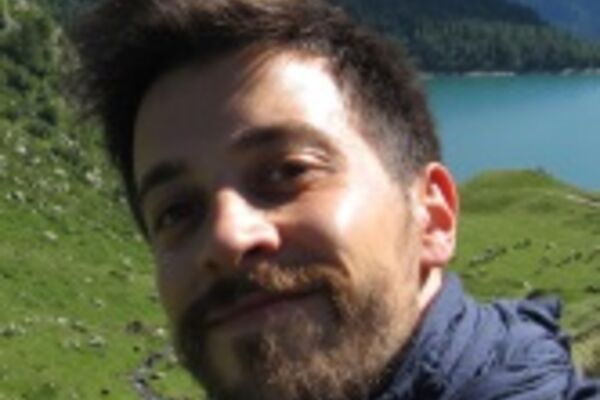
Lorenzo Brenna
Free lance journalist and contributor for LifeGate. I’m a story teller mostly about biodiversity conservation and sustainability. I also write about ethology and animal cognition for the Siua blog, the International School of human-animal interaction founded by the zooantropologist Roberto Marchesini. I love all natural environments (especially the mountains) and all animal species (especially amphibians). I’m following with concern the evolution of climate change and its impact on humans, animals and the environment. I am also interested in animal rights, plant intelligence and those economies that respect the environment and people. I constantly try to reduce my environmental impact and live light on this earth.
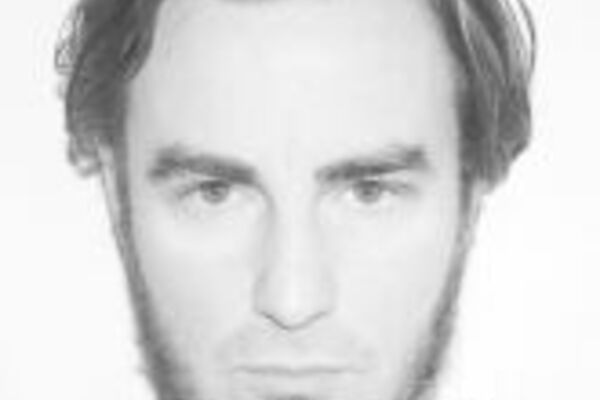
Raul Cazan
For more than five years, Raul is communicating EU’s policies in biodiversity and climate change as Editor-in-Chief of the cross-media environmental portal, 2Celsius Network, a product among few of this kind in Central and Eastern Europe. He has written books and researches on different themes related to environmental law and politics. He has decided that the academic arguments around green issues and their cultural projection must be dramatized. Thus, in 2015 he became a filmmaker while working on "Operation Climate" - a cross media participatory project carried out by ARTE TV that aimed at poetically expressing impacts of climate change in all corners of Europe. Operation Climate eventually became a full-fledged documentary that aired on ARTE TV in December 2015. He is currently a close collaborator of VICE in his home country, Romania, as well as of numerous other media.
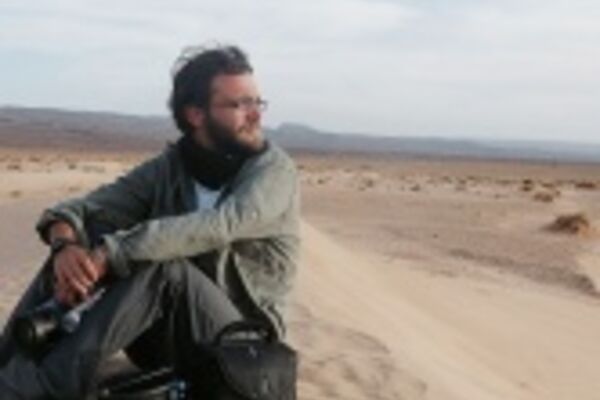
Andrea Ferrari Trecate
34 years old, graduated in Evironmental Law, I improved my journalism and communication expertise at CDCA (Centro Documentazione Conflitti Ambientali) in Rome and soon I started my collaboration with Istituto per l'Ambiente e l'Educazione Scholé Futuro and Educazione Sostenibile. I also work with several italian evironmental websites and magazines like Nonsoloambiente, Greenews, BioEcoGeo. I love photography and, thanks to the experience at ISFCI (Istituto di Fotografia e Comunicazione Integrata), is an essential part of my work too. I live in La Spezia, a small city in north Italy, placed between sea and mountains. Hiking is my passion and every time I can, I put my boots on to get lost in some trail.
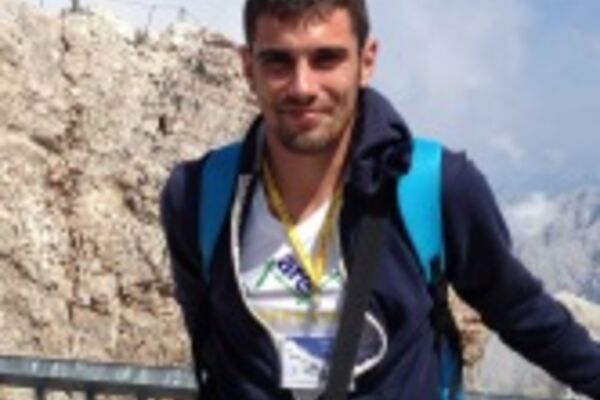
Filippo Marinoni
28 years old, employee at Associazione Ars.Uni.VCO. Responsible for the first Alpine Convention’s Infopoint set in Domodossola. He participated in the previous edition of WE ARE ALPS. He partook in the New Generations for the Alps project, sponsored by the Italian Presidency of the Alpine Convention. He is interested in the whole aspects of mountain’s life: ecology, economy, customs, sports and many other aspects, including communication. Since 2014 municipal councilor in Verbania City (VB).
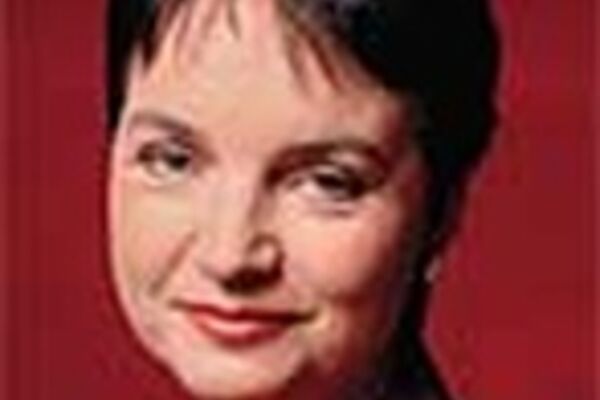
Vida Petrovčič
Vida Petrovčič is a renowned Slovenian television journalist and commentator covering economics, monetary policy, public finances, banking, energy production and policies, trade, privatisation and all other transitional topics of Slovenian economy. She has also played a prominent role as a reporter during the Slovenian war for independence.

Tjaša Potisk
I am 30 years old and working for the Slovenian National Television. For our daily news programme I cover wide areas of topics ranging from infrastructure, health, business news to environment and ecology. Especially environmental problems, effects of global warming, water pollution are topics dear to my heart. I was born in very flat area of Slovenia and 15 years ago I moved to our capital city Ljubljana which is very close to the mountains. Quickly I realised that there is nothing more relaxing than hiking up a big mountain and the views on the top are always breathtaking. So I can't wait to discover new places, new trails and stories that are just waiting to be told.

Maja Prijatelj Videmšek
My name is Maja Prijatelj Videmšek and I'm a journalist from main Slovenian newspaper Delo. I cover wide area of topics ranging from social issues, agriculture, food and health to environment and ecology. I was the initiator of weekly page in Delo about environmental topics and also write for it. Privately I'm a big nature and animal lover and enthusiastic gardener.
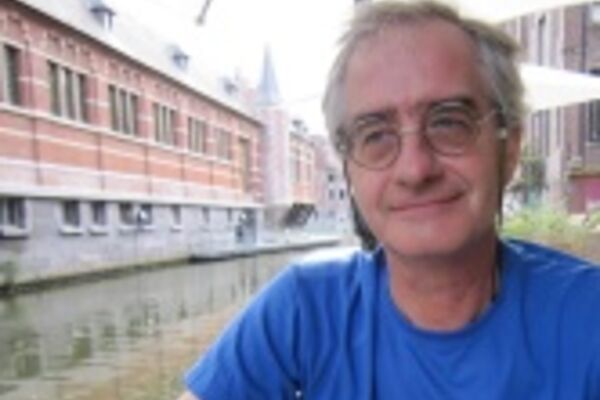
Christian Vanderwinnen
Christian Vanderwinnen is born in Brussels during the Christmas night 1950. Now officially retired he is still active in journalism and teaching. After 6 years in Brussels University (anthropology and journalism), his career was part in teaching tourism in different high schools and part in journalism and writing in belgian radio and different belgian magazines specialized in travel, trekking and mountain adventure ( travelling mostly in Africa and North America) . Large experience in trekking in the Alps (France, Valle d’Aosta,…) and in volcanic areas (Iceland, Réunion island, Kenya, Cameroon, Tanzanie) . He was also President of the belgian Youth Hostels Association for 14 years (1999-2013).
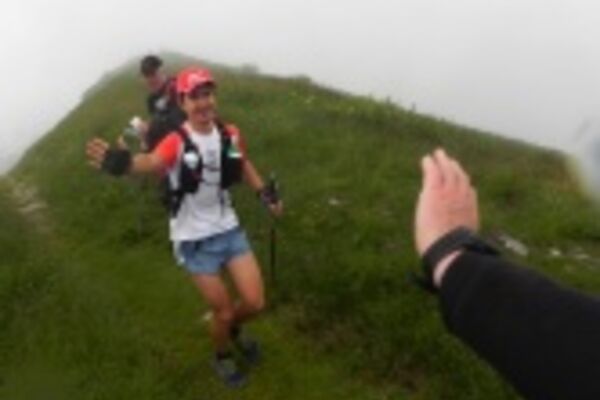
Mitja Volcansek
Mitja Volcansek, born in 1979, has a bachelor degree from the Faculty of Arts of the Ljubljana University, and has worked as a journalist for more than a decade now. In the last years he has worked as correspondent for the Slovenija Press Agency from the coastal region of Slovenia. an area that is rich in diverse natural resources, but is also facing many challenges due to its infrastructural development, all topics that he has also written about. He dedicates much of his spare time to walking and running in the mountains, which includes participating in ultra trail events, an activity that has helped him to develop a certain sensibility for the natural environment.
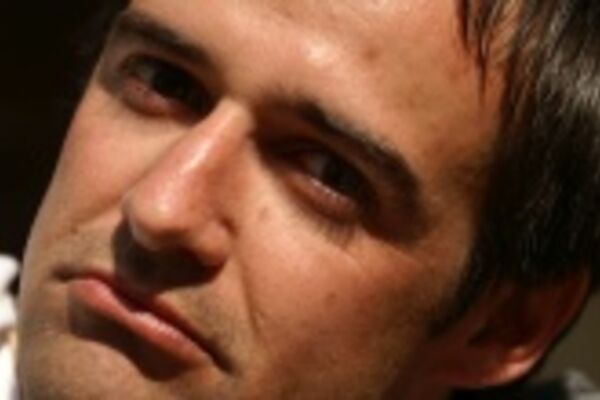
Alex Zingerle
Born 1972 in Bruneck, now employed as journalist at the daily newspaper “Dolomiten” and before that responsible for the magazine “IN Südtirol”. In my sparetime I write drama pieces, and do various types of sports such as tennis, soccer and biking. Obviously, I likes spending sunny weekends in the mountains, preferably in the “Dolomites”. Often enough I dedicate my articles to mountain topics – to the construction of new huts, to the maintenance of vie ferrate or to the simple life of farmers. I studied in Innsbruck modern languages.



































